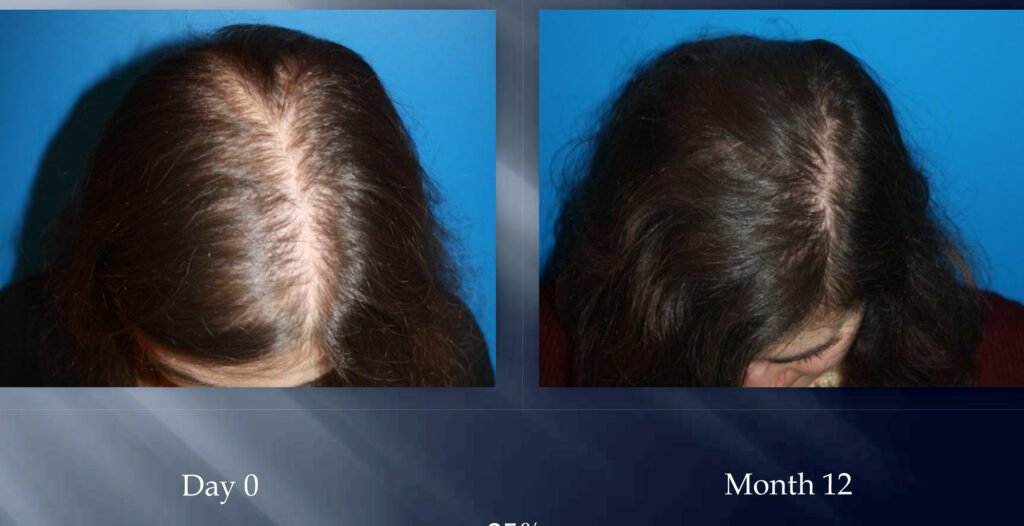Hair thinning in women is more common than most people realize — and often more emotionally distressing. If you’re a woman experiencing gradual hair loss, especially along the crown or widening part line, you may be dealing with female pattern hair loss (FPHL).
One increasingly popular treatment option is PRP (Platelet-Rich Plasma) therapy, a non-surgical procedure that uses your body’s natural growth factors to stimulate hair regrowth. But how effective is PRP for women? And is it the right choice for your unique medical and hormonal profile?
Let’s take a deep dive.
What Is Female Pattern Hair Loss?
Female pattern hair loss (also known as androgenetic alopecia in women) is a genetic and hormonally influenced condition characterized by:
- Gradual thinning of hair on the crown and top of the head
- A widening part line
- Hair that becomes finer and shorter over time
Unlike male pattern baldness, women typically don’t go completely bald but experience diffuse thinning, which can be emotionally challenging and difficult to treat.
What Is PRP Therapy?
Platelet-Rich Plasma (PRP) therapy involves drawing a small amount of your blood, spinning it in a centrifuge to isolate platelets and growth factors, and injecting that plasma into thinning areas of the scalp. These platelets contain proteins that help stimulate dormant or weak hair follicles, promote blood flow, and encourage natural hair growth.
How Effective Is PRP for Female Pattern Hair Loss?
✔️ Clinical Studies Support PRP’s Efficacy
Several peer-reviewed studies have demonstrated that PRP can:
- Increase hair count (density)
- Improve hair thickness (diameter)
- Slow or stabilize hair shedding
A 2019 review in the journal Dermatologic Surgery concluded that PRP is a safe and effective treatment for androgenetic alopecia in both men and women, with particularly good results when started early.
✔️ Works Best in Early to Moderate Stages
PRP is most effective when hair follicles are still active, even if they’re producing weaker or thinner hair. It may not help in areas of total baldness where follicles are no longer functioning.
Unique Considerations for Women
Hair loss in women is often multifactorial, meaning PRP should often be part of a broader treatment plan. Consider the following:
1. Hormonal Imbalance
Conditions like PCOS, menopause, thyroid dysfunction, or birth control changes can contribute to FPHL. These must be addressed to ensure PRP success.
2. Iron and Nutrient Deficiencies
Low iron, vitamin D, or ferritin levels are more common in women and can reduce PRP effectiveness. Bloodwork is often recommended before treatment.
3. Autoimmune Conditions
Conditions like alopecia areata or lupus may mimic FPHL. PRP has limited effectiveness in these cases and should be diagnosed properly via scalp biopsy or trichoscopy.
4. Stress and Telogen Effluvium
Women are more prone to stress-induced hair shedding, which can overlap with FPHL. PRP may help reduce shedding and accelerate regrowth once the trigger is resolved.
What to Expect from PRP Treatment
🕒 Treatment Timeline:
- Initial series: 3 to 6 sessions spaced 4–6 weeks apart
- Maintenance: Every 4–6 months after initial improvements
💉 Procedure Overview:
- Scalp is numbed with a topical anesthetic
- PRP is injected into thinning areas using tiny needles
- Session takes 45–60 minutes total
- Minimal downtime (most return to normal activities the same day)
📈 Results:
- First results typically visible by 3 months
- Peak results between 6–12 months
- Many patients notice reduced shedding, fuller hair, and improved scalp density
Pros and Cons of PRP for Women
✅ Pros:
- Natural treatment using your own blood
- Minimal risk of allergic reaction or side effects
- No scarring or downtime
- Can be combined with other therapies (minoxidil, spironolactone, microneedling)
❌ Cons:
- Not effective for everyone, especially in advanced stages
- Results are not permanent without maintenance
- Can be costly (typically not covered by insurance)
- May take months to show visible improvements
Is PRP Right for You?
PRP may be a great option if you:
- Have early to moderate female pattern hair loss
- Are looking for a non-surgical, natural solution
- Want to avoid or supplement pharmaceutical treatments
- Have realistic expectations and are committed to maintenance
However, PRP may not be effective if you:
- Have complete hair loss or scalp scarring
- Have underlying hormonal or autoimmune issues that are untreated
- Are pregnant, breastfeeding, or have a bleeding disorder
Conclusion: A Promising Option — With the Right Strategy
PRP therapy is an effective and safe option for many women with female pattern hair loss, particularly when combined with a personalized treatment plan that addresses underlying causes like hormone imbalance or nutritional deficiencies.
The key is to start early, get a proper diagnosis, and work closely with a board-certified dermatologist or hair restoration specialist to design a plan that works for your unique medical profile.




